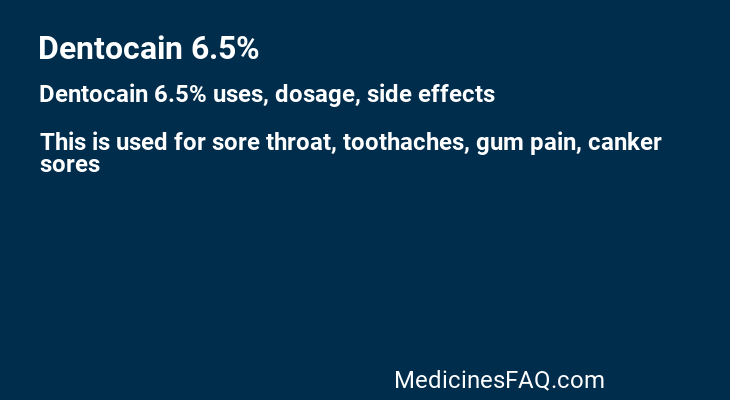Dentocain 6.5%
Dentocain 6.5% Uses, Dosage, Side Effects, Food Interaction and all others data.
Benzocaine binds to sodium channels and reversibly stabilizes the neuronal membrane which decreases its permeability to sodium ions. Depolarization of the neuronal membrane is inhibited thereby blocking the initiation and conduction of nerve impulses.
Camphor is a naturally occurring compound that is used as a major active ingredient of balms and liniments supplied as topical analgesics. Despite its long history of common medical use, the underlying molecular mechanism of camphor action is not understood.
Menthol is topically applied agents widely used for similar purposes, are known to excite and desensitize sensory nerves by acting on two members of transient receptor potential (TRP) channel superfamily: heat-sensitive TRP vanilloid subtype 1 (TRPV1) and cold-sensitive TRP channel M8, respectively.
Phenol is a potent proteolytic agent. Concentrations in the 5% to 7% range dissolve tissue on contact via proteolysis. In high concentrations when injected next to a nerve, phenol produces a chemical neurolysis which is nonselective across nerve fiber size and most prominent on its outer aspect. Local anesthetic effects occur within 5-10 minutes.
| Trade Name | Dentocain 6.5% |
| Generic | Benzocaine + Camphor + Methanol + Phenol |
| Weight | 065% + 0.25% + 0.25% + 0.45% |
| Type | Solution |
| Therapeutic Class | |
| Manufacturer | General Pharmaceuticals Ltd |
| Available Country | Bangladesh |
| Last Updated: | September 19, 2023 at 7:00 am |

Uses
This is used for sore throat, toothaches, gum pain, canker sores
Dentocain 6.5% is also used to associated treatment for these conditions: Acute Sore Throat Pain, Dental Pain, Gangrene Stomatitis, Gingivitis, Hemorrhoids, Laryngitis, Pharyngitis, Premature Ejaculation, Secondary Bacterial Infection caused by Tonsillectomy, Secondary Bacterial Infection caused by Tooth Extractions, Skin Irritation, Sore Throat, Stomatitis, Sunburn, Teething pain, Tonsillitis, Tooth Pain, Vomiting, Pruritic dermatosis, Ulceration of the mouth, Buccopharyngeal anesthesiaArthritis, Backache, Common Cold, Contusions, Inflammatory Reaction caused by Insect Bites, Joint Pain, Muscle Cramps, Nasal Congestion, Pain caused by Insect Bites, Rash, Skin Irritation, Soreness, Muscle, Sunburn, Swelling caused by Insect Bites, Minor burns, Neck or back pain, Shoulder acheDermatitis, Dermatitis, Eczematous, Irritation lips, Pruritis of the skin, Psoriasis, Ringworm, Sore Throat, Throat irritation, Moderate, stable Psoriasis
How Dentocain 6.5% works
Benzocaine diffuses into nerve cells where it binds to sodium channels, preventing the channels from opening, and blocking the influx of sodium ions. Nerve cells unable to allow sodium into cells cannot depolarize and conduct nerve impulses.
Phenol is a potent proteolytic agent. Concentrations in the 5% to 7% range dissolve tissue on contact via proteolysis. In high concentrations when injected next to a nerve, phenol produces a chemical neurolysis which is nonselective across nerve fiber size and most prominent on its outer aspect. Local anesthetic effects occur within 5-10 minutes.
Dosage
Dentocain 6.5% dosage
Adults: apply to the affected area not more than 3 to 4 times daily
Children 2 years of age and older: apply to the affected area not more than 3 to 4 times daily.
Children under 12 years of age: adult supervision should be given in the use of this product
Side Effects
Benzocaine are more likely to cause contact sensitization. Slight burning, tingling, or stinging may occur.
Toxicity
Patients experiencing an overdose may present with local anesthetic systemic toxicity syndrome, decreased cardiovascular function, decreased central nervous system function, cardiac arrest, bradycardia, hypotension, cardiac arrhythmias, syncope, and seizures. Patients should be treated with symptomatic and supportive measures which include airway maintenance, controlling seizures, and hemodynamic stabilization.
Mouse, Subcutaneous, LD50: 0.3-0.35 g/kg. (Duplay and Cazin, 1891; Tollens, 1905). Rat, Subcutaneous, LD50: 0.45. (Deichmann and Witherup, 1944). Rat, Oral, LD50: 0.53. (Deichmann and Witherup, 1944). Rat, Oral, LD50: 0.65. (Flickinger, 1976). Rat, Cutaneous, LD50: 0.67. (Conning and Hayes, 1970).
Precaution
Do not use over deep or puncture wounds, infections, or lacerations. Do not use for more than 7 days. When using this product avoid contact with the eyes, do not exceed recommended dosage. Keep out of reach of children.
Interaction
There are no known drug interactions and none well documented.
Volume of Distribution
At I5 min after exposure, the liver contained the highest level of phenol, consisting mainly of free phenol. After 82 minutes post administration, phenol is uniformly distributed in the liver, blood, kidneys, lungs, along with the heart, testes, thymus and the spleen. With the passage of time, the proportion of free to conjugated phenol changed. By 360 minutes most phenol appears in conjugated forms.
Elimination Route
Phenol is rapidly absorbed through the skin and into the lungs.
Clearance
In rabbits, 72% is excreted in the urine, 1% in the feces, 4% in the carcass following sacrifice, and trace amounts were exhaled.
Elimination Route
The kidney is the primary route of elimination of phenol.
Pregnancy & Breastfeeding use
Pregnancy Category: Not Classified. FDA has not yet classified the drug into a specified pregnancy category.
Contraindication
Do not use this product if you have a history of allergy to local anesthetics such as procaine, butacaine, benzocaine, or other "caine" anesthetics.
Acute Overdose
Symptom: Methaemoglobinaemia, manifested by cyanotic (greyish) skin discolouration, unusual breathing or breathlessness.
Management: Symptomatic and supportive treatment. IV methylene blue 1% may be administered.
Storage Condition
Store between 15-30° C.
Innovators Monograph
You find simplified version here Dentocain 6.5%







